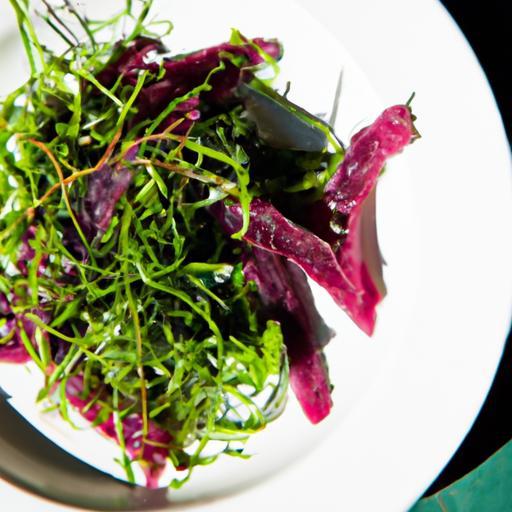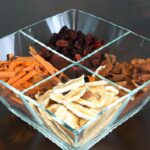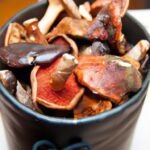In a world where the rush of modern life often separates us from nature’s quiet bounty, foraging offers a refreshing return to simplicity and seasonality. Among the many wild gifts that spring unfurls, the delicate violet leaf stands out-an unassuming green with a subtle tang and a whisper of floral charm. “Foraging Fresh: A Wild Violet Leaf Salad Recipe Delight” invites you to step off the beaten path and into a vibrant world of edible wilderness. Here, we’ll explore the art of finding, harvesting, and savoring these tender leaves, transforming them into a salad that celebrates nature’s understated elegance. Whether you’re a seasoned forager or a curious newcomer, let this recipe be your gateway to fresh flavors and the joyful rhythms of the wild.
Foraging fresh wild violet leaves offers an extraordinary opportunity to elevate your culinary adventures with nature’s own vibrant, nutritious greens. With their subtle earthiness and peppery undertones, wild violet leaves not only provide a unique flavor but also pack a rich boost of vitamins A, C, and calcium. When approached mindfully, harvesting these tender leaves connects us with the environment and unlocks the full nutritional potential of this often-overlooked woodland treasure.
Prep and Cook Time
Preparation: 15 minutes
Cooking: None (raw salad)
Total time: 15 minutes
Yield
Serves 4 as a refreshing side salad
Difficulty Level
Easy – perfect for beginner foragers and kitchen explorers alike
Ingredients
- 3 cups fresh wild violet leaves, rinsed and gently dried
- 1/4 cup extra virgin olive oil
- 2 tablespoons apple cider vinegar
- 1 teaspoon raw honey or maple syrup
- 1 small clove garlic, finely minced
- 1 teaspoon Dijon mustard
- Salt and freshly ground black pepper to taste
- 1 tablespoon finely chopped fresh chives
- 1/4 cup toasted walnut pieces (optional for crunch)
Instructions
- Careful foraging: Select young, vibrant violet leaves from clean, unpolluted areas away from roads or pesticide use. Pick sparingly to ensure sustainability-never harvest more than a third of any patch to encourage regrowth.
- Once home, rinse the leaves gently under cold water to remove any dirt or insects, then pat dry with paper towels or use a salad spinner to keep the leaves crisp.
- In a small bowl, whisk together olive oil, apple cider vinegar, honey, minced garlic, and Dijon mustard until the dressing emulsifies and thickens slightly.
- Season with salt and freshly ground pepper to your taste. Add the chopped chives to freshen the dressing with a mild oniony aroma.
- Place the cleaned violet leaves in a large bowl, and drizzle the dressing evenly over them. Toss gently to coat without bruising the delicate greens.
- Top with toasted walnuts for an optional nutty crunch, adding texture that harmonizes beautifully with the soft leaves.
- Serve immediately to experience peak freshness and vivid color.
Tips for Success
- To enhance the vinaigrette, experiment by adding a squeeze of fresh lemon juice for brightness or a pinch of crushed red pepper flakes for subtle warmth.
- Use wild violet flowers as an edible garnish to add delicate pops of purple and a touch of floral sweetness.
- Ensure all foraged leaves are young and tender, as older leaves can be bitter and tougher.
- Make the dressing ahead of time and chill it-this melds the flavors and makes tossing more efficient.
- For a creative twist, add other foraged leaves like dandelion or chickweed to balance the flavor profile and expand nutrient diversity.
Serving Suggestions
This wild violet leaf salad thrives paired with a crusty artisan bread and soft goat cheese, bringing nuances of creamy tanginess that complement the herbaceous greens. For a heartier meal, top with grilled chicken breast or pan-seared wild salmon, drizzled lightly with extra olive oil. A crisp glass of chilled Sauvignon Blanc beautifully balances the peppery notes of the leaves, enhancing the freshness of the entire dish.

| Nutrient | Per Serving |
|---|---|
| Calories | 120 kcal |
| Protein | 2 g |
| Carbohydrates | 5 g |
| Fat | 11 g |
For those eager to deepen their knowledge of wild edible plants, check out our complete guide to safe and sustainable wild foraging. Additionally, for comprehensive botanical insights on wild violet identification and uses, the Wild Edibles website is an excellent resource.
Q&A
Q&A: Foraging Fresh – A Wild Violet Leaf Salad Recipe Delight
Q1: What makes wild violet leaves a fantastic ingredient for salads?
A1: Wild violet leaves are a delightful foraged treasure! Tender and slightly sweet with a hint of earthiness, they offer a fresh, vibrant taste that adds a subtle complexity to any salad. Plus, they’re packed with vitamins A and C, making your dish nutritious as well as beautiful.
Q2: How can I confidently identify wild violet leaves while foraging?
A2: Wild violet leaves are heart-shaped with a soft, slightly fuzzy texture. They grow low to the ground in clusters, usually in shaded, moist areas like woodlands or grassy fields. Look for the distinctive purple flowers in spring to confirm your find, but always be sure to forage in unpolluted areas to keep your salad safe and healthy!
Q3: Are there any precautions to take before eating wild violet leaves?
A3: Yes, it’s wise to wash the leaves thoroughly to remove any dirt or tiny bugs. Also, avoid harvesting from areas where pesticides or herbicides are used. While wild violet leaves are generally safe, if you’re trying them for the first time, start with a small amount to ensure no allergic reactions.
Q4: What would a simple wild violet leaf salad recipe include?
A4: The recipe is refreshingly simple! Combine a generous handful of fresh wild violet leaves with baby spinach, thinly sliced radishes, and toasted walnuts. Dress lightly with a lemon-honey vinaigrette to complement the leaves’ natural sweetness. Finish with a sprinkle of crumbled goat cheese or feta for extra creaminess.
Q5: Can wild violet leaves be used beyond salads?
A5: Absolutely! Their mild flavor and tender texture make them perfect for smoothies, herbal teas, and even as a gentle addition to springtime soups. Some adventurous cooks even fold them into savory pastries or blend them into pestos.
Q6: When is the best season to forage wild violet leaves for this salad?
A6: Early spring is prime time-they’re at their freshest and most tender before the warmer months when the leaves can become tough. Foraging early also means harvesting before the plants fully bloom, ensuring a delicate flavor and optimal nutrition.
Q7: How does foraging for wild ingredients like violet leaves connect us to nature?
A7: Foraging invites us to slow down, observe, and engage deeply with the natural world. Harvesting wild violet leaves means understanding the rhythms of the seasons, recognizing sustainable practices, and savoring the flavors of true wilderness. It’s a delicious celebration of nature’s bounty that nourishes both body and soul.
The Conclusion
As the wild violet leaves whisper their subtle, sweet secrets to your palate, this foraged salad becomes more than just a dish-it’s an invitation to reconnect with nature’s quiet bounty. Embracing the art of foraging not only enriches our meals but deepens our appreciation for the wild spaces that surround us. So next time you wander through the woods or meadow, pause and discover the fresh, vibrant flavors hidden beneath the fern fronds and grasses. With this wild violet leaf salad recipe in your culinary arsenal, you’re ready to turn every walk into a delicious adventure, celebrating the freshness of the earth one leaf at a time. Happy foraging!


